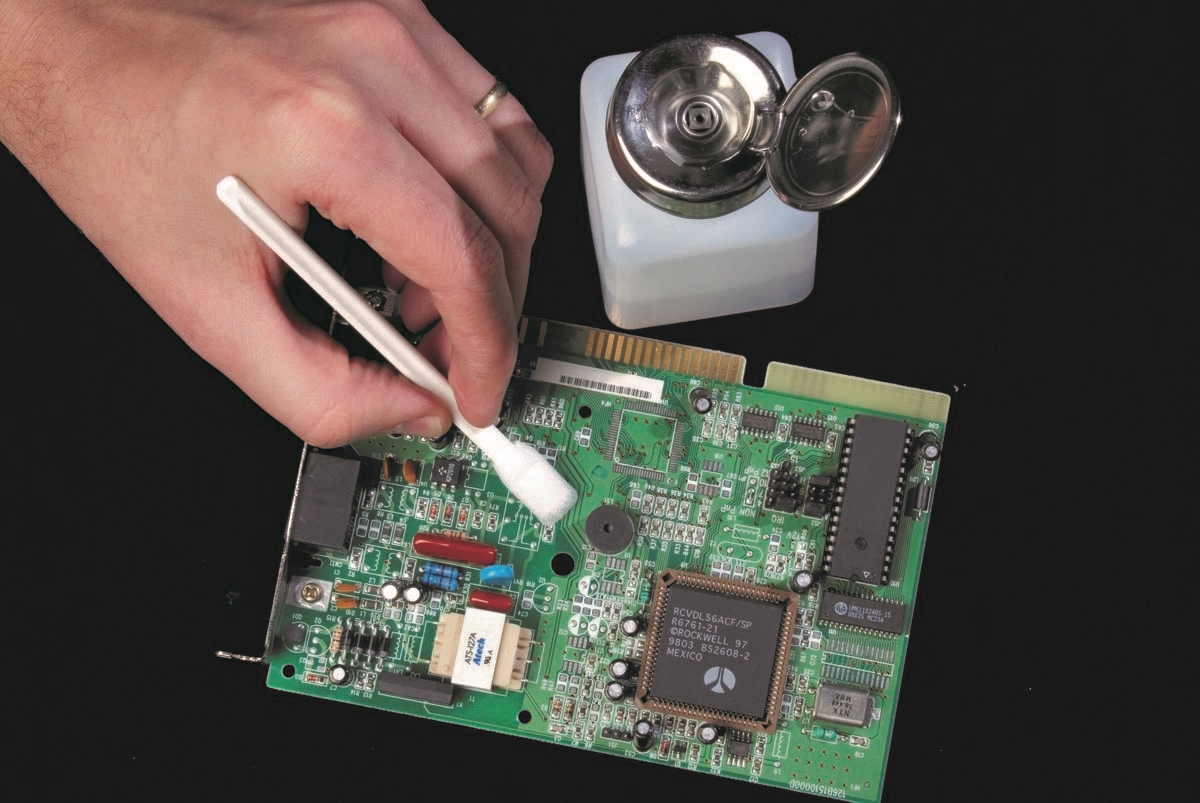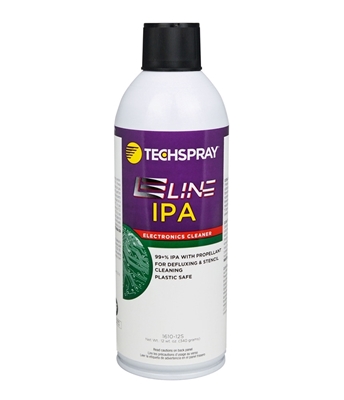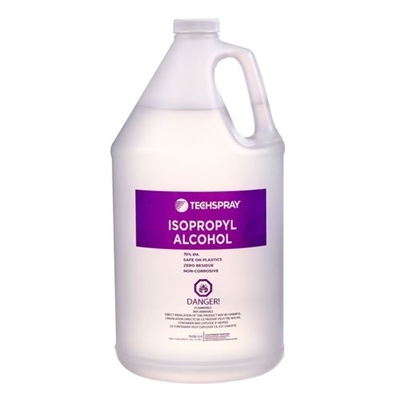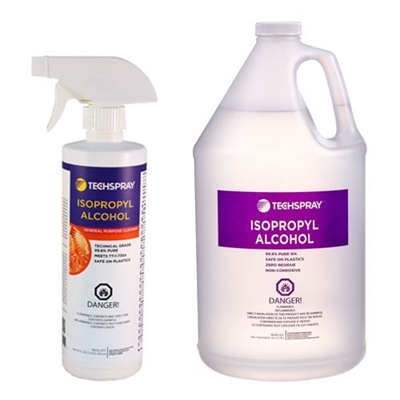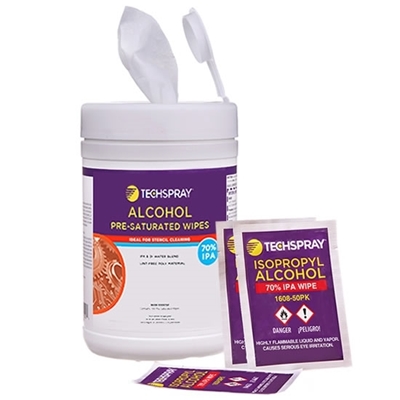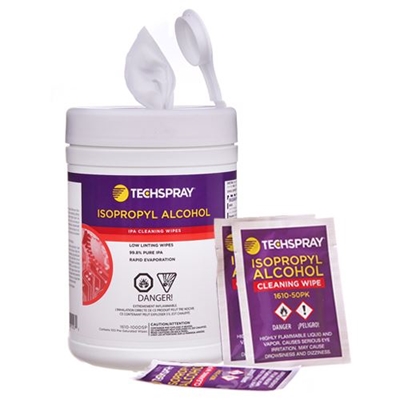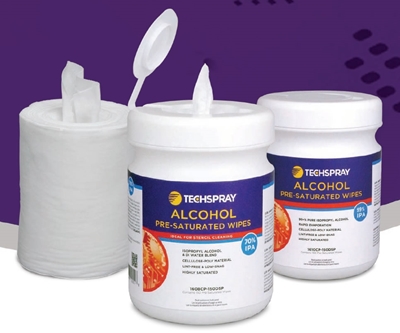A variety of chemicals can be found throughout the electronic assembly and repair process, but no solvent appears more commonly than isopropyl alcohol. It is universally used for cleaning and as a main constituent of fluxes, but how much do you really know about isopropyl alcohol?
Isopropyl alcohol (CAS #67-63-0) is also referred to as IPA, isopropanol, 2-propanol, and even rubbing alcohol (more on that later). It dissolves a wide range of both polar and nonpolar soils, and is often used to dissolve and remove light oils, fingerprints, cutting fluids, flux residues, carbon deposits, and mold release. It is also readily miscible in water, which makes it an effective drying agent.
For electronic printed circuit board (PCB) assembly, you will find isopropyl alcohol being used either to clean flux residues from recently soldered circuit boards, or in PCB repair and rework. IPA is also used to remove solder paste or adhesive from SMT stencils. Maintenance cleaning with isopropyl alcohol is common for removing caked-on and burnt-on flux from SMT reflow ovens, wave soldering fingers, selective soldering nozzles, pallets, and anywhere else flux tends to collect in automated soldering processes.
Material compatibility of Isopropyl Alcohol
Isopropyl alcohol is generally compatible with most materials used in electronics. As with any chemical product used, component compatibility must be determined on a non-critical area prior to use. The following are a list of common materials used in PCB assembly and their respective compatibility ratings:
| Material | Compatibility |
|---|---|
| Aluminum | Excellent |
| Buna-N | Good |
| CPVC | Excellent |
| Epoxy | Excellent |
| Neoprene | Good |
| Noryl | Excellent |
| Phenolic | Excellent |
| Cross-Linked PE | Good |
| Polycarbonate | Poor |
| Polypropylene | Good |
| Polystyrene | Poor |
| PVC | Fair |
| Teflon | Excellent |
| Tygon | Good |
| Viton | Excellent |
When a solvent is not compatible with a substrate, it may cause crazing (micro-cracks) or soften the material. In the case of seals or gaskets, this incompatibility will cause parts to swell, shrink, or become brittle. This video shows an extreme example of acetone on polycarbonate, which causes it to fog, soften, and even scratch from contact with the plastic dropper.
Grades or Types of Isopropyl Alcohol
Isopropyl alcohol is available in a large number of varieties and grades, which are generally differentiated by the amount of water in the solution and trace amounts of other chemicals or nonvolatile materials.
Isopropyl alcohol is hydrophilic, so it readily accepts water into an azeotropic solution. When you see on the label “70% isopropyl alcohol”, it refers to amount of alcohol in relation to the amount of dissolved water – i.e. 70% alcohol to 30% water. Water can be removed to form purer grades of isopropyl alcohol, resulting in what is called “anhydrous” isopropyl alcohol.
Whether an IPA has 0.2% or 50% water has little effect on the look and smell of the material, but greatly impacts surface tension (its ability to wet) and the dry time. The more water isopropyl alcohol contains, the greater the surface tension. This causes the solvent to bead up more as it dries rather than wet or sheet, which can lead to spotting. “Water spots” are particularly problematic when cleaning mirrors, lenses, and other optics.
The dry time is greatly increased as the percentage of water in the alcohol solution is increased. This can be an advantage or disadvantage depending on the application. For example, isopropyl alcohol is often used as a flux remover to remove flux residues from around solder joints. Technicians tend to prefer a fast dry time so that they can clean the electronics and bring them back into service as quickly as possible. When breaking down and removing thick, gummy, or baked-on materials, more dwell or soak time is required. Slowing down the dry time often improves the cleaning effectiveness. That is one of the reasons 70% pure isopropyl alcohol is commonly used for degreasing and SMT stencil cleaning. In the case of electrical contact cleaning, the faster evaporation time helps ensure that the flammable solvent is gone before energizing the equipment.
This video shows the comparative evaporation rate of 50% pure IPA, 99.8% pure IPA, and 100% pure acetone.
The following are typical grade designations of isopropyl alcohol, their respective specifications, and their operating procedures:
- ACS / reagent grade - meets or exceeds purity standards set by the American Chemical Society (ACS). This grade is specified for food, drug, or medicinal use and other applications that require strict quality specifications and purity over 95%.
- USP grade - meets or exceeds requirements of the United States Pharmacopeia (USP). For food, drug, or medicinal use in addition to most laboratory purposes.
- NF grade - meets or exceeds requirements of the National Formulary (NF). USP and NF have combined, so USP is generally the entity which is referenced.
- Laboratory grade - most popular grade for use in educational applications, but exact amount of impurities are unknown.
- Purified grade - also called “pure” or “practical grade”, this meets no official standard and not pure enough for food, drug, or medicinal use.
- Technical grade - is used for commercial and industrial purposes but is not pure enough to be utilized in food, drug, or medicinal use of any kind.
The general term “rubbing alcohol” is often used for isopropyl alcohol, but users looking to buy a specific grade of alcohol should avoid products labeled that way. Rubbing alcohol does not refer to a specific grade, and may even be a different type of alcohol, like ethanol (also called ethyl alcohol, CAS #67-17-5). Consumer rubbing alcohol can also contain other ingredients like denaturant, fragrances, and colorants that are potential contaminants. ASTM D770 (currently on revision 11(2019)) is the standard specification for isopropyl alcohol published by ASTM International.
Application Methods of Cleaning with Isopropyl Alcohol
As mentioned above, isopropyl alcohol is also available in different grades, or percentages of solvent to water, to fit a variety of specific applications. When deciding on the best isopropyl product for a particular manufacturing or repair process, first decide on the grade of solvent, then the packaging.
Isopropyl alcohol is easily dispensed in a variety of packaging types to fit requirements for various applications:
- Bulk containers - Isopropyl alcohol is packaged in 1 gallon bottles, 5-gallon containers, 54-gallon drums, and even totes for automated dispensing. In most cases, a spigot can be attached to the 1 and 5 gallon containers for convenient dispensing in benchtop or workstation use. When transferring to another container, make sure the smaller bottle is properly marked with the chemical name and warning information.
- Small bottles / spray bottles - To avoid the risk and hassle of pouring and labelling smaller containers, isopropyl alcohol is also available in smaller plastic containers like pints and quarts. Some have a trigger spray attachment for convenient cleaning.
- Pump dispensers / dauber bottles - Empty bottles are available to make dispensing even more convenient. A wipe or swab can be saturated in the opening, which is filled with a valve when the user pushes down. This keeps the isopropyl alcohol sealed, which avoids cross contamination when a wipe is resaturated after use, causing it to draw in moisture from the ambient air. These bottles can come with a variety of features including ESD-safe materials and a selection of labels for standard chemicals like IPA.
- Aerosol cans - An aerosol can is a sealed container, so it has some of the advantages of a pump dispenser. In addition, the propellant forces the solvent out of the can, creating agitation as it hits the substrate.
- Presaturated wipes - For the ideal mix of form and function, wipes are available, and are already saturated with isopropyl alcohol. They can come in pop-up tubs where the wipes are pulled up from the top, plastic boxes or pouches that reduce linting caused by wipe perforations, and even individually wrapped packages. The individually wrapped wipes are perfect for field maintenance because they fit neatly in a tool box.
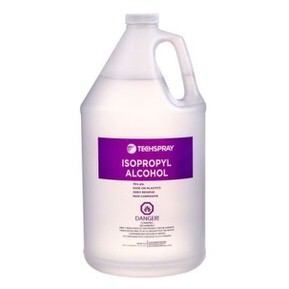
1 gallon
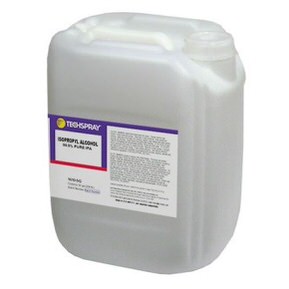
5 gallon
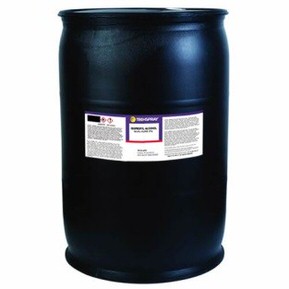
54 gallon drum
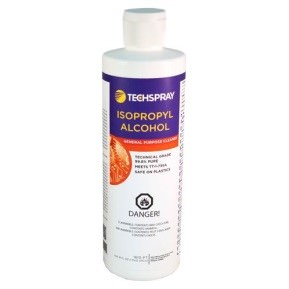
1 pint
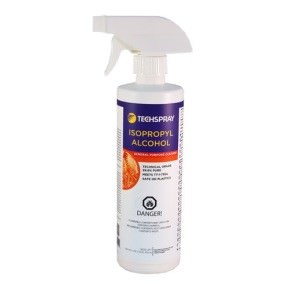
1 pint with trigger sprayer
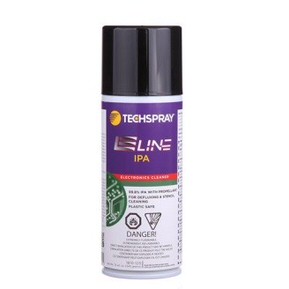
10 oz aerosol can
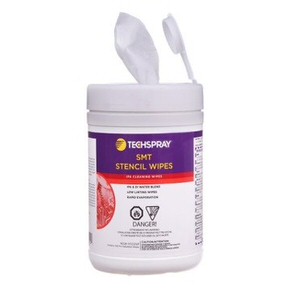
Alcohol wipes in pop-up tub
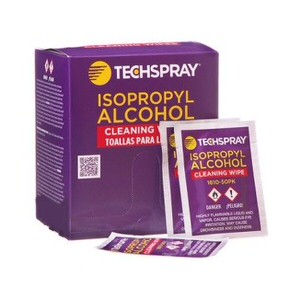
Individually wrapped alcohol wipes
Safely Handling Isopropyl Alcohol
Although isopropyl alcohol is generally considered safe if handled properly, it is a flammable solvent, so precautions need to be taken to prevent a dangerous situation from developing.
- Ventilation - the work area must be adequately ventilated to prevent an accumulation of vapors, which could combust. Ventilation should be explosion-proof.
- Storage - because isopropyl alcohol is very flammable, it needs to be stored in a closed container in a cool, well-ventilated area away from ignition sources like heat, sparks and flames. It has an NFPA rating of 3, so it should be stored in a cabinet or room designed for that type of hazardous material. If solvent is transferred to another container, make sure it is marked with the chemical name and required warning information.
- Personal protection equipment - isopropyl alcohol has a tendency to defatten the skin, which means it draws out the protective oils from the skin and can lead to dermatitis if improperly handled. Gloves made of nitrile or other solvent-resistant materials should be worn. Glasses or even a face shield should be worn if the user is spraying an IPA product, or if splashing could occur. Respirators can be used if ventilation is not adequate enough to avoid breathing in a high concentration of vapors.
- Disposal - isopropyl alcohol needs to be disposed of as a hazardous liquid according to state and local requirements. It certainly cannot be flushed down the drain, and additional disposal requirements may need to be followed depending on the soils dissolved in the waste material.
- Safety Data Sheets (SDS) - The central resource for all safety requirements is the SDS, which should be readily available wherever isopropyl alcohol is used.
Conclusion
Is it any wonder isopropyl alcohol can be found in all corners of electronic PCB assembly, rework and repair operations? It is effective, reasonably priced, and safe if handled properly. To buy isopropyl alcohol in the grade and packaging that is best for your application, go to www.techspray.com.

